Gardening in Portugal may seem like a gardener’s paradise but my plants are plagued by far more pests and diseases then they ever were in the UK. Or maybe it’s just my garden and the bugs arrive to dine on my plants as they would at a Michelin star restaurant. My six on Saturday for this week (aka SoS and play on words) focus on some of the challenges faced over the last few days, I’d love to hear from anyone who also experiences these problems and how they overcame them. OR if you can suggest any tried-and-tested organic alternatives to insecticides.
1. Madagascar Cactus Palm – a Tale of Woe
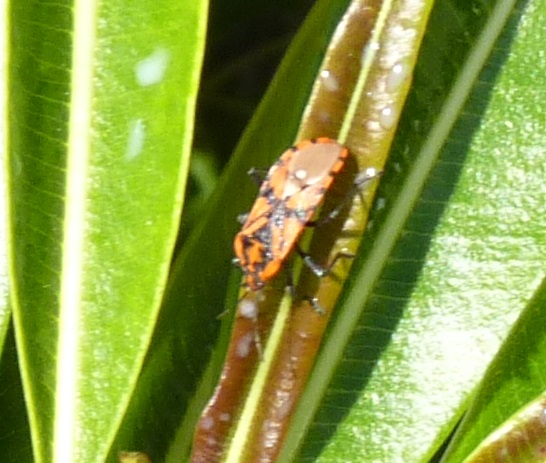
I was inspecting my Madagascar Cactus Palm (my pride and joy) when I noticed squatters had moved in. I’d never seen this specie of insect in my garden before, so I had a moment. Were they friend or foe? I posted their mugshot on a couple of cacti and succulent FB groups and after a few false starts we identified it as a Spilostethus pandurus.

In the meantime. I panicked in case the female was laying eggs so I sprayed with a pre-made insecticide. Big mistake! It had no effect on the bugs but the effect on the leaves is devastating.
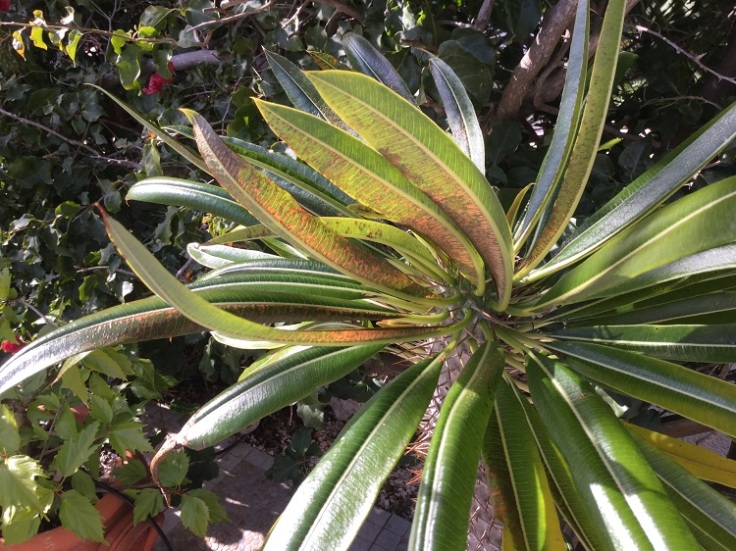
**

Eventually, I discovered the red insects were Spilostethus pandurus and unless they were on vegetables where they had a vociferous appetite, the jury is still out if they are friend or foe on this plant.
While I was procrastinating the OH came to the rescue, removed the bugs by hand and they are now in bug heaven.
2. Slugs and Snails
Who knew Slugs and snail liked Kalanchoe. This is the first year they’ve attacked these plants so it came as quite a surprise. I buried some slug pellets at the base of the plants, removed as many snails as I could see (and fed to the birds) then sprayed the leaves with soapy water. Actually, considering the fate of the cactus palm, it is lucky I did not spray these with insecticide.

***

Apart from soapy water on the leaves please can anyone suggest any other deterrent?
3. Scale Invasion on Crested Eve’s Needle
I am not sure what more I can do to save this plant.
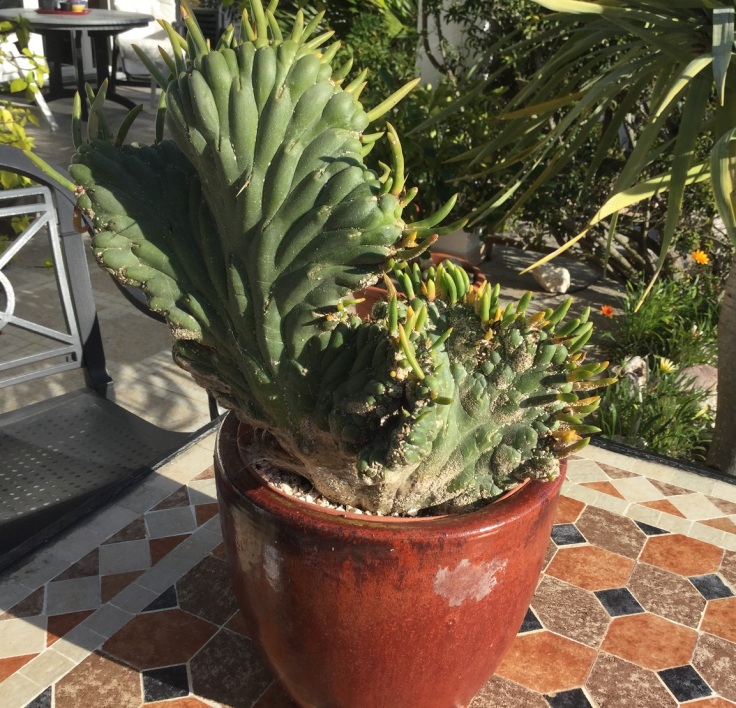

I completely cleaned and repotted it back in July.
Crested Eve’s Needle Fungal or Scale
Now the scale is back. My fault, I should have kept a closer eye on the plant. Friends say I should throw it away. I can’t.
I have also noticed scale on the Kalanchoe Luciae (Paddle Plant)

and on

Anyone else experience problems with scale and if so how did you eradicate it?
4. Citrus Leaf Miner
The citrus leaf miner is a continual challenge. Because the larvae mine below the surface of the leaf, pesticides and other treatments are mostly ineffective. I don’t spray the tree I remove all the affected leaves by hand.

I’ve just discovered there are traps available to stop the circle of reproduction as they attract the male moth.
I wonder if that or something similar is available in Portugal
5. Problem with Freesia Leaves – Is it fungal?
I researched the RHS website and they do not list this as an issue (as far as I could see).
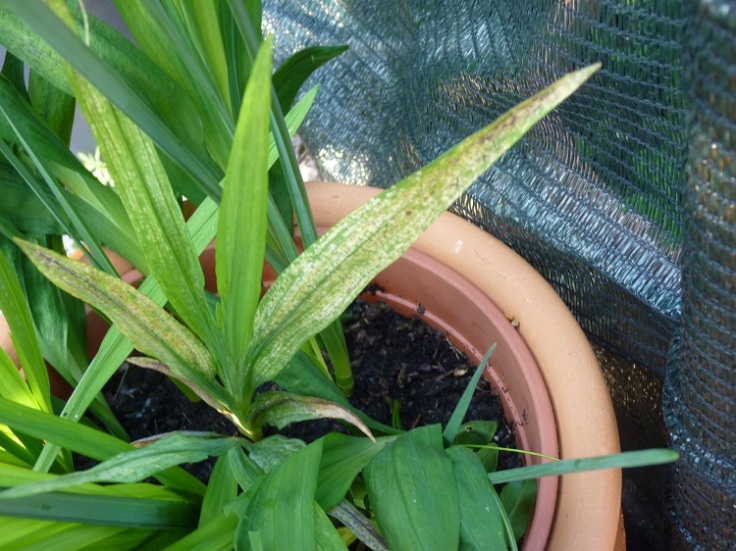
Come on you garden gurus… any ideas, please?
6. Curly Honeysuckle Leaves

This is a classic example of an unhappy plant. The mother was beautiful. Covered in strong healthy leaves throughout the year with an abundance of flowers as and when. This sickly specimen must have been the runt of the litter. Its leaves are always curled in protest and it hardly produces any flowers. It’s now 7 years old and this year I will cut it back and find it a new home.
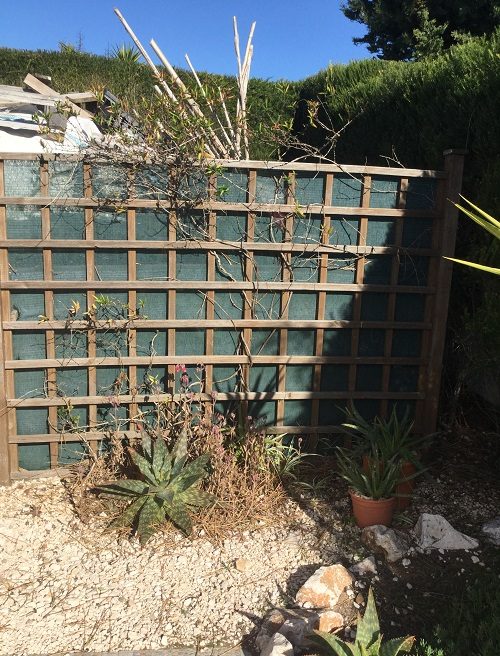
That’s my six and my gardening woes for this Saturday. If you would like to join the six on saturday gardeners from all over the world check out the Propagator’s Blog
And PLEASE don’t forget: if you can suggest any organic solutions or otherwise to the above challenges don’t forget to share.


Goodness, the pests definitely try to break a gardener’s spirit. I wish you much luck in controlling them.
LikeLiked by 1 person
The bugs here are certainly a challenge. I gave up growing courgettes because I could never get them to set properly.
LikeLike
Oh dear I feel for you. There are lots of good ideas here. Just to add another potential tool to your arsenal: I have had some success using neem oil against scale on citrus.
LikeLiked by 1 person
Neem, yes I have some neem oil. What recipe do you use?
LikeLike
I make up a spray using 1 teaspoon neem to roughly half a litre of warm water (I add a few drops of the provided emulsifier to make the solution homogenised)
LikeLiked by 1 person
I have a lovely, indoor weeping fig tree that was suddenly infested with scale. I took it outside and soaked it with special oil meant to smother scale. The oil smelled like rotten fish guts. In two months the scale was back healthier than ever. I finally bought a jar of powdered systemic insecticide. I sprinkled it on the dirt and watered it in. That seems to have done it. Of course, the fig is indoors and wildlife aren’t feeding on it.
LikeLiked by 1 person
Thanks, Nate. Interesting I’ve been researching all the different options for scale removal and to me the sponsored systemic insecticide does seem the best option as it protects the plant from the inside out. You’ve just confirmed what I suspected. I can protect the plant so the wildlife can’t get at it. I don’t like using chemicals but in this case it’s a last resort.
LikeLiked by 1 person
I had success with beer traps for snails. I used smallish plastic containers buried in the garden so the tops were level with the soil. I added beer and because MrMG wasn’t keen on me using the good stuff, I used low alcohol. I don’t really know how it works, but the snails seemed to drown in the beer. I didn’t need to fill the containers to the top and in fact, when it rained and watered the beer down, the snails were still attracted to it.
LikeLiked by 1 person
Thanks, Jane. IT’s good to know. I wonder is it the yeast in the beer that attracts them?
LikeLike
It’s a mystery to me! Hope it works for you.
LikeLiked by 1 person
Oh my! I enjoyed this read, but absolutely had no clue on deterrents! This is why I love SOS! I learn so much!
LikeLiked by 1 person
I was delighted to discover SoS and have learned so much already through reading other sixes and the suggestions they have put forward to me.
LikeLiked by 1 person
I know exactly what you mean! I have too! There are some very creative and worthy gardeners here!
LikeLiked by 1 person
The freesia seems to be infested with gladiolus thrip. There are likely other thrip that can cause the same damage. I would say that it is some sort of thrip.
LikeLike
Thanks, Tony. Now I ahve a sense of direction, I can do some research 🙂
LikeLiked by 1 person
You are welcome. I am sorry that I can not provide a more precise identification.
LikeLike
Tony, I have been researching thrips and I think, i have infestations on other plants. One of which are the silvery patches on the tayberry and strawberry leaves. Apparently thrips also like honeysuckle! So I am going to take a closer look at that.
If anyone else is interested here is a link
https://www.rhs.org.uk/advice/profile?pid=876
LikeLiked by 1 person
There are several types of thip, and some are quite specialized. The Ficus trees in Southern California can be damaged by banyan thrip, but banyan thrip do not bother anything else. It is possible that the thrip that damaged the freesia also damaged the tayberry and strawberry, but they might alternatively be different thrip. It may not matter in the end, as long as they are all just as dead, or at least controlled.
LikeLike
Oh dear! I can’t offer any help since (apart from slugs and the occasional snail, although, like Mr P, we had far fewer slugs last year). Hope you find some solutions.
LikeLiked by 1 person
Fingers crossed. I am going to try the beer trap.
LikeLike
You’re having a rough time of it. I use beer traps (well, Sainsbury’s basics lager) and they do quite a good job with slugs. Wool pellets and copper tape have been used but the results are mixed. I think they may work better with slugs than snails, the latter seem far more cunning. In the spring and summer, before heading to bed, I go on patrol in the garden with my trowel and do a bit of bashing and slicing and then lie in bed hoping there’s no such thing as karma.
LikeLike
In the spring and summer, before heading to bed, I go on patrol in the garden with my trowel and do a bit of bashing and slicing and then lie in bed hoping there’s no such thing as karma.
as long as you recycle them to the birds you should be fine 🙂
I’ve just set a couple of beer traps. Fingers crossed they work.
LikeLiked by 1 person
I also get Citrus leaf miner and will have to get that product. The scale infestation seems quite bad in that plant. Have you tried washing them off with soapy water and alcohol? I’ve never had it that bad, usually just a bit that I wash off.
I don’t use pellets for the snails (we usually get them in winter, rainy period) because of my cats, so we put out beer in tins and let them climb in and drown. Hope you have some luck with the Succulent Society.
LikeLiked by 1 person
Hi Sami, yes, I’ve spent hours washing them off with a paintbrush. I am now on a ‘scale’ research mission
LikeLike
Yikes, it’s war in your garden! Am not familiar wi5h most of your pests, s&s being the exception. I confess to using the nasty blue pellets, although last year was surprisingly free ofnthe. Too hot I think. I’ll have to do something different as the blue pellets will soon be banned. Good luck with your beasties!
LikeLiked by 1 person
I think we have GM snails and slugs here. They don’t seem to mind the heat but they are most certainly more prevalent in the winter when we have a lot more rain and humidity.
I did not realise they were banning the blue pellets. I’m going to try the beer suggestion for the slugs and snails and see if that helps.
LikeLike
Not plants I am familiar with, but I do know about scale! I had a lovely Yucca and an Umbrella plant (Schefflera / Heptapleurum) indoors which were both quite large and very beautiful until they got attacked by scale insects. I used a spray especially for it, I washed them carefully with soapy water. I hand-picked the scale from the leaves – all to no avail. They just kept coming back. In the end sadly I had to bin both plants 😦
Hopefully someone with more cactus/succulent knowledge will read this and come to your rescue. Have you tried asking at a local nursery for help?
(For small infestations you could start by picking off the scale insects by hand and rubbing the affected plants with a cloth soaked in alcohol.) I’m guessing not whisky!
LikeLiked by 1 person
I did not realise they attacked other plants, especially those growing indoors. That’s a real shame about your Yucca and Umbrella plant.
Our local nurseries don’t tend to be too hot on on giving advice and at most I get the Portuguese shrug. I have just joined the Algarve succulent society (first meeting end of Jan) so I think I’ll take along my iPad with all the photos and see if anyone else has experience any similar problems.
LikeLiked by 1 person
Good idea!
LikeLike
Many problems, a lot of pests in your garden without frost in winter … I’ll try to answer those I have too. First, your Kalanchoe Marmorata is very beautiful (I also have a few slugs and beer trap is a solution just like organic pellets). Scales on cacti … I also have them on the pads of my opuntias. I read that there is no hope … So I chose to cut the old diseased pads, and graft new young plants on the healthy parts (but also to take cuttings).
About Citrus leaf miner, I kill all of them by hand, like the bugs of the #1 ( I have some that look like on lilium regale )
Good luck and keep us informed about all of them
LikeLiked by 1 person
Thanks, Fred. I’ve been in denial for months over the Eve’s Needle. It is one of the most expensive plants in my collection soooo I have been loath to abandon it. Sigh… I think I’ll try one more time with rubbing alcohol. REmove the plant from soil wash it completely, disinfect and plant again. If the scale returns then… 😦
At the moment it is in isolation. I’m not sure what causes scale or how it spreads. I’ll need to research. Who said cacti and sucs are easy to grow must live in paradise.
I’ve never tried grafting? Is it easy?
I have a couple of opuntias varieties. One is deadly for the little hairy needles. I better check to see if that has scale.
Have you tried using traps for the citrus leaf miner?
LikeLiked by 1 person
I grafted 2 opuntias with a drill. ( 12mm ) (Yes … I watched a quick video on Twitter about it and if I find it again, I’ll send you the link). Not tried traps for the leaf miner. I only have a few in general in September and I had to check every day: it was enough.)
LikeLike
Here is my twitter link which shows the result 8 months after graft. I cut a pad horizontally, pierced a hole of 12mm in the flat part after healing. I formed the bottom of the other pad in 12mm cylinder and I interlocked them. That’s all. https://twitter.com/frdvil/status/996409454630522880?s=21
LikeLiked by 1 person
Hi there,
You do have some pests – how annoying for you! I wouldn’t know how to get rid of some of them but encouraging more birds will defiantly help. The plant with scale I would throw away I think as it will spread but I think there’s an oil you can get to help? Not totally sure, sorry.
I have written a post about slugs and snails
https://oldhouseintheshires.com/2018/12/28/7103/
I have used SlugGone which are wool pellets, they were brilliant last summer and I would recommend highly.
Happy new year to you. X
LikeLiked by 1 person
Laughing… our garden is full of birds. Who like to steal my strawberries and other precious fruit. I hear them eating the snails as they bang the shells against the closest hard surface. The Blackbirds make me smile because when they see me, they stop, look at me, and then carry on.
I’ve not tried SLugGone I only have some basic slug pellets from homebase which I only use under controlled conditions. I’ll see if I can get it here, or if not when we return to the UK
HAppy New YEar 🙂
LikeLiked by 1 person
Some lovely coloured leaves on the kalanchoe. I’ve found a mixture of barrier and beer traps good for slugs and snails. But beer traps may evaporate up to quick in your heat.
LikeLiked by 1 person
I’ll give the beer a try and report back. And least the snails will meet their maker with a smile on their face and they should be safe for the birds to eat.
LikeLike
I had a few hit windows after, but can’t directly link that to drunken birds as seagulls hit quite often.
LikeLiked by 1 person
Oh dear woes indeed! I guess another way to look at it is that you are providing a haven for wildlife?!!!
LikeLiked by 1 person
the wildlife certainly do like to party in my garden. I wouldn’t mind but there is miles of wild natural park the other side of my fence. Laughing… I suppose why feed on burgers when you can hop over the hedge and feed on rump steak. 🙂
LikeLiked by 1 person
That’s exactly what they’re all thinking, you now just need to alert all the birds to what the insects are all feeding on!!
LikeLiked by 1 person